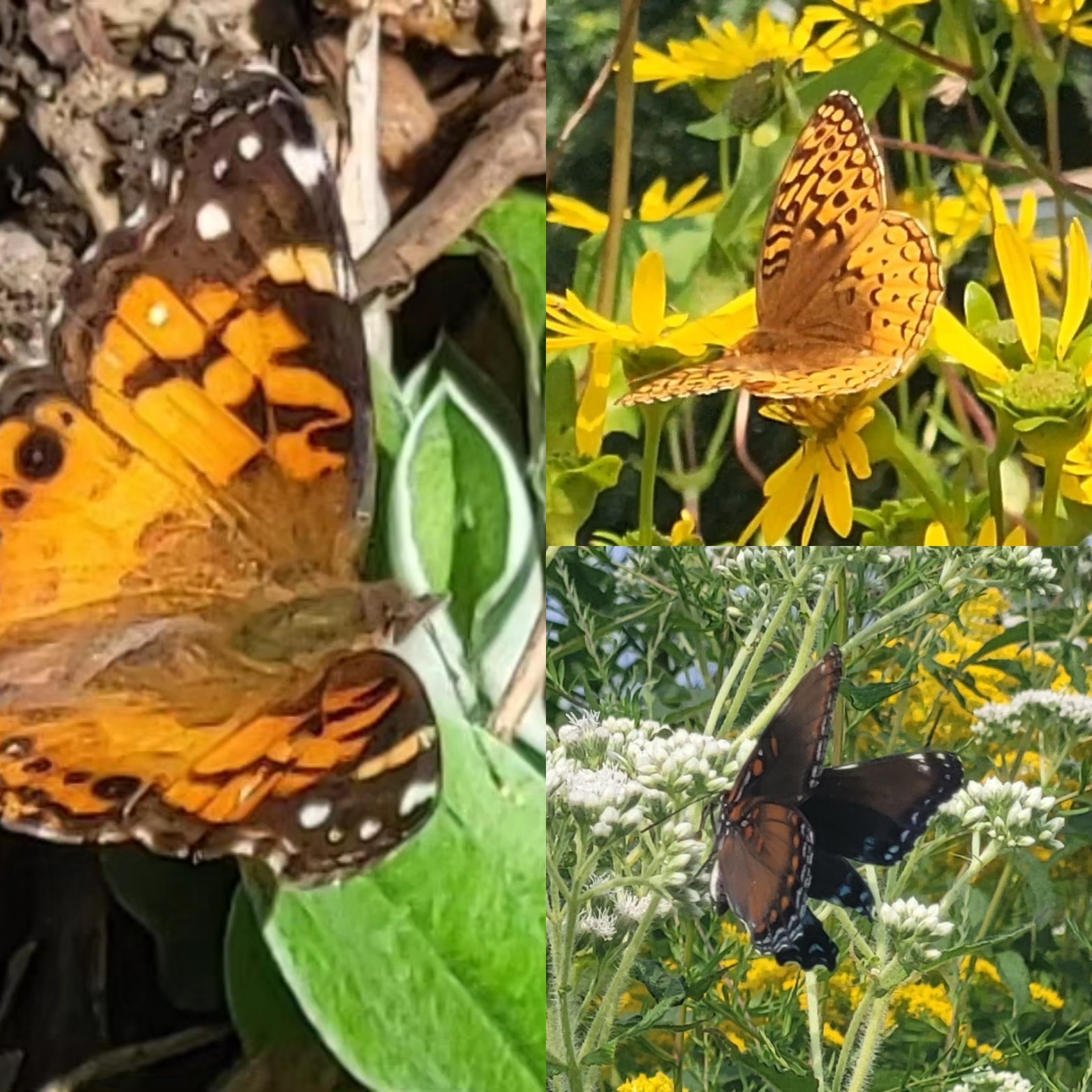I think my Midwestern soul is turning Yankee. I used to love a good two-for-one project. But now I’m getting greedy with my desire for frugal use of time and resources. I want a three-for-one or a four-for-one project; I call this a ‘four-fer’, four benefits from one endeavor. I say this because we can, this fall, strategically ready our yards and gardens (‘yardens’ in my world) for more of the berries, birds, and butterflies we want to enjoy all next spring, summer, and fall. Here’s a three-step strategy that not only accomplishes more birds, berries, and butterflies but also improves the health of the environments we all live in -with no additional effort. Three steps, four benefits. Boom.
STEP ONE – Bring all of the colorful packages of deadly herbicides and pesticides currently in your garden shed, basement, and garage to your community’s next Household Hazardous Waste disposal day. Yup, this is the safest way to dispose of these so-called garden chemicals. Why? Because 22 of the 30 most commonly used pesticides are toxic to birds, 29 are toxic to pollinators, period. More ‘why’? Americans use over 10x the amount of these chemicals than actually needed. We don’t like to read the instructions.
No toxic chemicals in our yards next year? Poof! More insects (particularly beetles, caterpillars, and grasshoppers) to feed the birds we love. As well, more pollinators to pollinate the berries we love. If these products are not in your gardening shed next spring, you’ll be less tempted to use them. And now we’ll be proud of the holes in our plants’ leaves because the caterpillar that ate our plant’s leaves fed both adult and baby birds. You probably have heard that parent birds need 6-7000 butterfly and moth caterpillars to feed one clutch of babies during their two-week rearing period. They’re counting on us to help them feed their babies what they need. Caterpillars = Best Baby Bird Food. Ohio-based naturalist Jim McCormac calls caterpillars “…nature’s hotdog.”
STEP TWO – Guard Your Fall Leaf ‘Soft Landings’ Under Your Oak and Cherry Trees
Yes, of course, add your other fall leaves to your compost bins, blanket your food garden beds with your fall leaves for more humus and nutrients, and protect the roots of your shrubs and perennials from winter winds with blankets of fall leaves the way the snow used to do, and, wait for it, feed your trees. 🙂 But for our goal of more berries, birds, and butterflies, we want to do as Heather Holm, a biologist, and pollinator conservationist has written, protect all of the fallen leaves within the dripline of all of our Oak and Cherry trees for the entire winter until late spring. Butterflies and moths camouflage themselves to overwinter in the leaves below their host tree. Butterflies and moths hide in their chrysalis and cocoons until late spring. These winter nests or sleeping bags are also camouflaged with the colors and textures of their trees’ leaves. Raking, blowing, and shredding Cherry and Oak leaves within each tree’s driplines kill these baby butterflies and moths. We want them to wake up and grace us with their glorious presence next spring!
STEP THREE – Plant Native Plants to our Northeastern Highlands Ecoregion (https://plantfinder.nativeplanttrust.org/Plant-Search)
Berries, seeds, and shelter from native shrubs and perennials are the most effective and efficient way to protect and support the birds we love. In particular, Winterberry, Viburnum, Chokeberry, Serviceberry, and Nannyberry, to name just a few native shrubs, are terrific for the berries our birds need. As well, The North American Butterfly Association suggests the following native perennials and shrubs that support (feed and host) butterflies and moths: Swamp Milkweed, Butterfly Milkweed, Common Milkweed (aggressive), New England, New York, Stiff, Blue Wood and White Wood Asters, Purple Coneflower, Joe-Pye Weed, Bee Balm, Black-eyed Susan, and Black Cohosh. Recommended shrubs that feed and host butterflies, moths, and their caterpillars include New Jersey Tea, Sweet Pepperbush, and Buttonbush. Fall is a terrific time to plant these plants. Water them well, and protect them with a ‘doughnut/blanket’ of leaf mulch around their base. They’ll be in the ground already and have their roots growing as our spring rains begin.
Responsibly disposed of herbicides and pesticides, protected winter leaf cover below Oak and Cherry Trees, and a variety of native plants create a three-pronged approach to a more enjoyable next spring, summer, and fall of more berries, birds and butterflies, and a healthier home habitat at your house -a fabulous four-fer!
You’re welcome.
Michele Chalice is a 30-year experienced environmental landscape designer and owner of Healthy Home Habitats which provides design services, and ecological landscape stewardship mentoring to homeowners. She also offers public programs and workshops in the Monadnock region. See her in person this month presenting ‘Keep the Leaves’, on THU, SEP 14 AT 6 p.m. at the Monadnock Food Co-op in Keene. LIKE and FOLLOW her on FB and IG for more ecologically restorative home landscape stewardship tips. You can also reach her by phone at 603-313-9153 or by email at hhhabitats@gmail.com

